- Saving
- Some Important Numbers
- Investing in Shares (Stocks)
- Buying Shares
- Weekly and Monthly Routines
- Managing Your Share Portfolio – Charts; Stop Losses; When to Sell
- Three Pile Theory
- Investing in “peace of mind” – Health; Relationships
- Portfolio Performance and Benchmarking
The Slack Way to Financial Freedom: Episode 1 – Saving
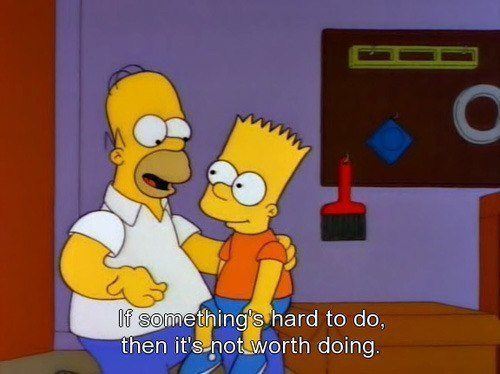
Generational wisdom … Homer style. – From Source (May be subject to copyright)
Now Slack Investor admits to being a lucky bloke. and recognizes that many are doing it tough and just haven’t got the income to engage on a savings program. This post is not for you, and I hope that your fortunes will turn around soon. This post is the first in a series – for people with choices on how they spend their income.
Save more than you spend … Duh! – Obvious you would think – Sorry Homer, It is worth doing!
According to a June 2018 Members Equity survey , of Australian households, less than half of them are putting something into the savings bucket each month.
Households who ‘typically spend less than they
earn each month’ (i.e. savers) eased further to 48%
Not only are the savers decreasing, but at the other end of the scale, the number of households that are in financial distress is increasing. The ME Bank report shows that more Australians are overspending – households who ‘typically spend all of their income and more’ increased 3 points to 11% during the six months to June 2018. Cripes!
Now the hard truth is out there … what can you do? Slack investor doesn’t pretend to have invented how to save. Any financial website will contain similar information. The advice is sound because it works. Just get started … this is the first step
1.”Go and have a long hard look at yourself in the hall of mirrors”
Thanks to Roy and HG, we have an expression to make introspection more popular. Analyze your financial situation … Over a month or two, see what is coming in and what is going out. Many banking apps assign categories for your monthly spending in your statements. A pen and paper would do, but free software makes this task easy ( e.g. for PC, MS Money Sunset (Slack Investor way); or Phone: Pocketbook). Track your financial habits – you have to get an idea of what is going on in your financial world first … and then, take control.
2. Set yourself some savings goals. ...
Now the interesting part, and this is the “Art of the Possible”. Be realistic here and set goals that you can actually get done. Unless you can you work more hours or get an additional job, it is difficult to adjust the income side. The real power you have is over your spending. There are some things that you just have to spend – Rent, Bills, food etc. However, it is the discretionary things that need looking at. It doesn’t mean that you cant have fun anymore … just less expensive fun!
“The purpose of discipline is to live more fully, not less.” Master Po – From Kung Fu (see below)
The objective is to build up some savings – for a house or retirement. Naturally, if you have any personal debt (Credit Cards, Personal loans) you should get rid of this first. Keep your savings account separate from all others. The best savings method is what works with you – It can be a jar, or a monthly transfer from your transaction account to your savings account. Young Slack investor always found saving easier if he didn’t see the money. – A direct debit just after payday into your savings account will get this done.
What you should aim for when you get your first full-time job is to set up good habits. There is a good “Rule of Thumb” known as the 50:30:20 rule where you divide up your take home salary into parts – 50% for essentials, 30% for discretionary items (Fun!) and 20% for saving. There is a little bit of mathematics to back up this 20% savings rate. The Money Under Thirty table calculates that it will take 41 years of 20% saving (earning 5%) to get your savings to 25 times your inflation adjusted income – This is the amount that is generally agreed to be sustainable using investment earnings to replace your income, using the 4% rule.
Do not despair with these calculations, they are just a rough guide – and there are some things going in your favour as:
- You don’t need to replace your whole income in retirement – just enough to cover your yearly expenses.
- Over the long term, investment return earnings would hopefully better than 5% – this will get you to your goal quicker.
- In Australia, if you earn over $450 per month, your employer is already contributing 9.5% of your wages to your retirement savings (Superannuation).
- In Australia, we are in the very fortunate to have Medicare, a universal health system that subsidises health care for Australian citizens and permanent residents.
- Although Slack Investor encourages readers to aim for complete financial independence in retirement. Under current rules, for Australians, there is a “sweet spot” for home owning couples of $400 000 in superannuation savings. Using a mix of the Age Pension and Super, couples can have a retirement income of $52,395 per annum. This bizarre sweet spot will be expanded upon in later posts.
3. Build an emergency fund.
In June 2018, a significant majority of households (62%) continued to report that they ‘could not easily raise $3,000 for an emergency’ – a percentage point lower than six months ago … ME Bank survey
Do not be part of this 62%, it is so important to have that “cushion of cash” – from which your financial independence can build. You must be ready for the many unexpected things that life can throw at you -$3000 in an online account is a good start and will help you sleep better at night.

Youtube excerpt from Kung Fu (3:35) where wisdom is imparted from Master Po to Grasshopper (May be subject to copyright)
The next part of the Slack Way to Financial freedom is Investing. But, to paraphrase Master Po from the old TV Series (1972) Kung Fu
“Grasshopper … you are not ready for this … until you have mastered saving”
PS … If the discipline of saving gets too much, I recommend a bit of Youtube Roy and HG magic (12:39) here for light relief.
The Slack Way to Financial Freedom: Episode 2 – Some Important Numbers
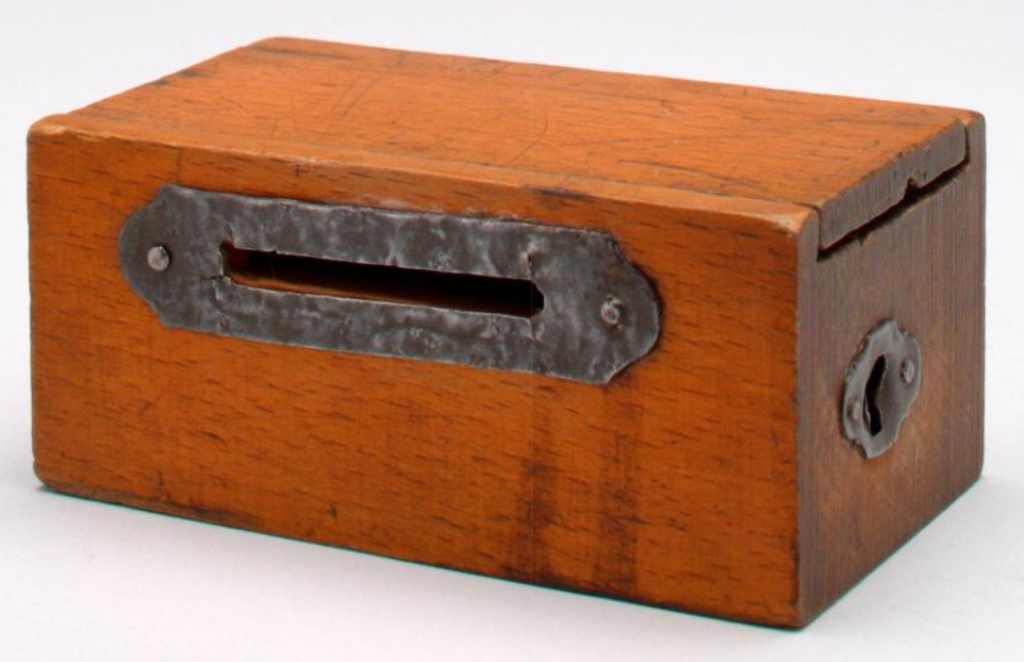
There are many numbers to note in finance world – Fees, Investment returns, etc. However, there are two extremely important numbers when it comes to financial independence. Both are percentages and the first one is the 4% “rule of thumb” and the second is your savings rate.
The 4% Rule
All followers of finance blogs would have heard of this often quoted “rule” Slack Investor acknowledges that this magic number is arguable and depends on individual circumstances but, it is an excellent way to estimate how much you will need to retire. The 4% rule is a way to “roughly” link assets with income. For example, as an estimate, if you would like to generate a $40 000 yearly income, you would need to have investments assets of $1 000 000 to earn this income using the 4% rule (4% of $1 000 000 = $40 000).
Another way of looking at this 4% rule is that you need to save 25 x your annual spending for your retirement fund so it can generate an income to cover your spending. So, if you spend $30 000 a year, you need a portfolio of $750 000 (25 x $30 000). To get an idea about what your expenses are it is important that you track them over a year using a spreadsheet or finance software. If necessary, this investment income can always be supplemented by a government pension or a part-time job.
Bill Bengen originally came up with this “4% safe withdrawal rate” in 1994. He developed it by backtesting a conservative US portfolio with data dating back to 1920 and tried to get a safe withdrawal rate that would generate an income for at least 30 years. He is the first to admit that the 4% number was always treated too simplistically and has since updated the rate to be closer to 4.5%.
Slack Investor is a bit old fashioned in liking to hold on to most of the capital that is earning the money and has a flexible approach to how much to extract from investments each year. I regard all dividends and distributions to be mine to spend – even when the market performs poorly. Most of the Slack fund is in Australian Investments and in 2021, the Australian Index has a 12-month forward dividend yield of 3.5% . Hopefully, the shares will also increase in value over time. Over the past 10 years, Australian shares had a total return of almost 7% – with growth shares you can aim higher, but prepare for volatility. In the good years, I will also take out a bit of capital gain for extra spending. All of this is in addition to the stable income component of my investments.
Your Savings Rate
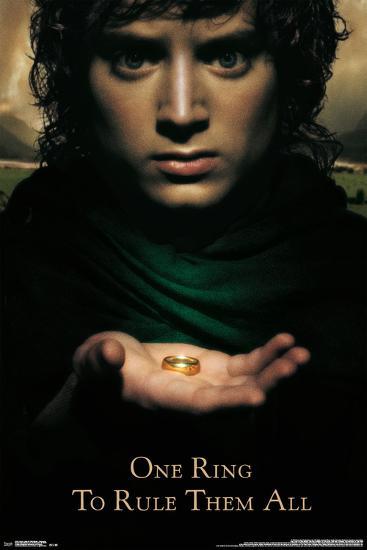
“Wealth consists not in having great possessions but in having few wants.”
Epicetus
Using the 4% rule we estimate how much will give us a sustainable retirement. But there is another number to add to our arsenal.
Just as in Lord of the Rings there is ” one ring to rule them all…”, there is also one “percentage” to rule them all in the Financial Independence world – and that is the Savings Rate percentage.
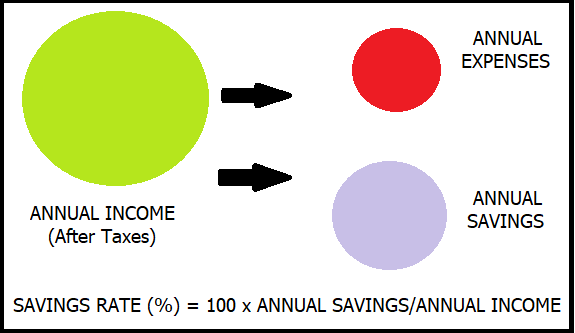
The annual expenses is critical here as this is the figure you are trying to generate out of investment income. Lets have a look at the effect that savings rate has on the number of years that you have to work until you can sustainably generate your expenses from your investments. The table below is from the great financial blogger Mr Money Mustache. There are a few assumptions used to generate this table
- Your investments earn 5% after inflation
- You can live from the “4% safe withdrawal rate” after retirement.
Here’s how many years you will have to work for a range of possible savings rates, starting from a net worth of zero:
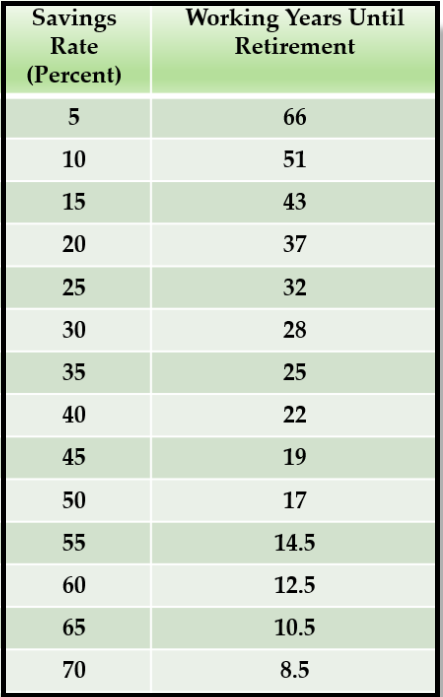
At a saving rate of 10% you will have to work for over 50 years – we have to do better than that! There are some pretty heroic savings rates amongst financial bloggers e.g Aussie Firebug 61%; Dividends Down Under 61%; I have admiration for these savings rates and note that these bloggers are in a hurry to get to financial independence – and retire early. At 60% savings you can retire after 12.5 years of working and saving – but that sounds pretty hard.
Slack Investor was on a much slower train and lucky that he quite enjoyed his job – and didn’t mind spending 30 years saving for his retirement. I have always been a good saver but, when looking at my past savings rates, it was usually around the 30-40% level and, some years had dropped down to 20%. Raising a family and holidays are a delightful interference with savings and you just have to find a balance. In Australia, we have compulsory superannuation which currently adds a welcome 9.5 % to your savings rate.
A beautifully presented calculator at Networthify shows how the savings rate works and gives a yearly breakdown. It also shows some interesting OECD statistics for average National savings rates (e.g. The US 6%, and India 32%). The aim is to eventually save enough money to invest in a way that you average (at least) 5% return on your investments after infation. If you withdraw from this retirement pool at the rate of 4% and have enough to cover 100% of your expenses – you become financially independent – the retirement pool keeps on giving!
Automate your savings
One of the best financial habits that I formed was to take the thinking out of saving and set up automatic recurring transfers from my work money to my savings or investment accounts – Pay Yourself First. I also took full advantage of “concessional contributions” to my super account which were taxed at 15% rather than my then marginal rate of 37%.
So, automate your savings. Investment returns are important and we hope that we can exceed the 5% after inflation returns that the above table and 4% rule are based on. However, the number you have most control over is your savings rate – and that is most important.
The Slack Way to Financial Freedom: Episode 4 : The Slack Buying Process

As much as Slack Investor hates retail shopping – he loves to have the opportunity to buy into companies. Like any new relationship, when you buy a stock, you are not really sure about how its going to work out – but its exciting!
I have never been good at predicting when the stock market will have a correction … and the current high valuations (PE Ratios well above the long term average) do make me nervous. However, Slack Investor would much rather be in the game than out of it and I have been looking for a few companies that would hopefully not suffer too greatly if a correction occurred in the stock market.
This is not advice … just an insight to the Slack Investor bumbling buying process. My rate of converting bought shares into winners of 55% is not that impressive – but my overall performance results are good.
I get heaps of buying ideas from investment sites such as Motley Fool, Livewire, ShareCafe. But I will always, always, check things out for myself before parting with any Slack Dollars. This involves a rigorous screening of the fundamental financial metrics PLUS a look at how the stock chart is going on Incredible Charts. This technical analysis consists of a quick scan to see if the chart is in a continual growth trend … or has just had a “breakout”, or broken out of a downtrend.
Let’s put on the buying boots. As well as the companies below, Slack Investor has also recently added to some small positions in PPK.ASX and TNE.ASX.
Slack Investor Buys Alphabet GOOGL.NASDAQ)
Half of my buying cash went into an existing holding – Alphabet (GOOGL), This money making juggernaut is part of the new economy and I could buy this company all day. The first step is to go to the phenomenal MarketScreener.com. Registration is free on this site and they allow you to look at analyst data for up to 5 stocks a day.
Search for your stock and then finding the Financials Tab for that company. Firstly, I look at the chart Income/Sales and Earnings per Share. An increasing trend is good and, if the estimated earnings (2021 – 2023) are also increasing, I’m acutely interested. I do a quick check on debt levels. Alphabet is a cash king – has more cash than debt – solid tick.
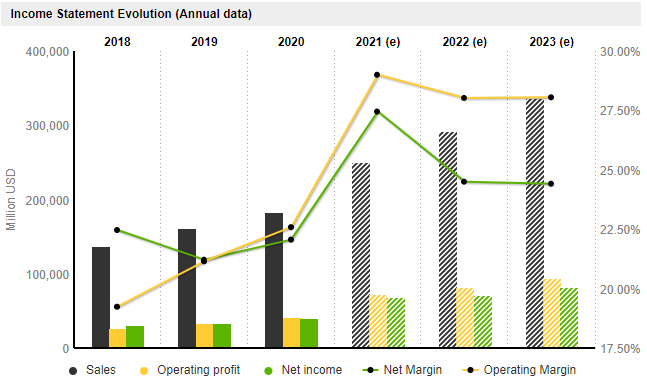
I continue with MarketScreener to extract the Return on Equity (ROE), both past and forecast. I hope that it is above 15% – Big Tick. The final bit of vital information is the Price Earnings (PE) Ratio and it is here that I gauge whether the stock price is too high for Slack Investor. For a good growth stock, I try not to buy into companies that have a projected PE of more than 40-(50 at a pinch). The analyst estimates for GOOGL is a forecast PE of 23.0 in 2023 – Tick
| YEAR | 2018 | 2019 | 2020 | 2021(e) | 2022(e) | 2023(e) |
| ROE | 18.6 | 19.3 | 19.0 | 27.2 | 25.8 | 25.2 |
| PE Ratio | 23.9 | 27.2 | 29.9 | 28.0 | 26.6 | 23.0 |
Table of fundamental financial metrics for Alphabet. The documented Return on Equity (ROE) and Price Earnings (PE) Ratio are shown for 2018-2020. Analyst estimates are shown for later years – MarketScreener.com
Slack Investor Buys NASDAQ 100 ETF (NDQ.ASX)
Not everyone has access to direct access to US shares – if you only have an ASX broker, then to get exposure to Alphabet, a good substitute is to buy the BetaShares NASDAQ ETF (NDQ) – Alphabet represents 8.1% of this ETF – and you get profit machines like Apple, Amazon, Microsoft and Facebook thrown in. I topped up my holding here as well.
The ROE for the NASDAQ Index is 17.7 and increasing (30 June 21) – Above 15, Tick. The projected 2023 estimate for the Price/Earnings Ratio for the NASDAQ Index is 22.47 – Below 40, Tick – Very reasonable for growth sector companies.
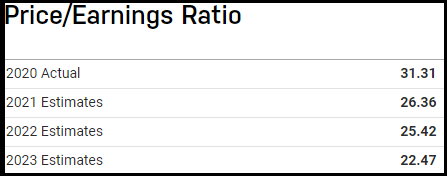
Slack Investor Buys Coles Group (COL.ASX)
| YEAR | 2019 | 2020 | 2021(e) | 2022(e) | 2023(e) | 2024(e) |
| ROE | 29.8 | 32.8 | 37.0 | 34.9 | 33.3 | 34.3 |
| PE Ratio | 12.4 | 22.9 | 22.4 | 23.4 | 22.8 | 21.4 |
Table of Fundamental metrics for Coles Group . The documented Return on Equity (ROE) and Price Earnings (PE) Ratio are shown for 2019-2020. Analyst estimates are shown for later years– MarketScreener.com
The Return on Equity (ROE) for this retail business is pretty impressive and, the PE Ratio would be pretty good for a growth company – but the Income Chart below reveals that Coles is not really a “growth” company – so the expectation is that the PE Ratios should be much lower, in the early 20’s or below would be the Slack Limits for slow growth companies.
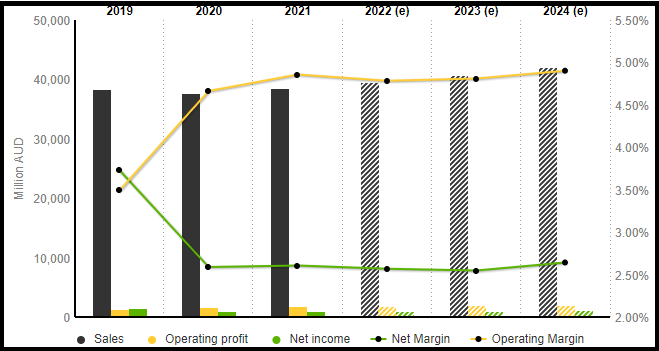
The income chart shows some pretty shallow growth and the slow earnings per share (EPS) growth makes the Coles Group something that Slack Investor would not usually be interested in. But, I go to Coles Supermarket at least twice a week and I actually like going there as a company part owner. Coles is in the “stable income” section of the Slack Portfolio rather than “Growth”. Even if the worst of times was thrust upon us and there was a recession in the next few years, a business like Coles will keep on performing. I would much rather put up with the price fluctuation of shares and have my money in a business like this at a projected yield of 3.5 – 4% p.a. than have Slack Dollars tied up in cash for 2 years in a Big 4 bank term deposit at 0.3%.
The Slack Way to Financial Freedom: Episode 5 – Weekly and Monthly Routines – Always Watching

Slack Investor is not known for his fast work … and have often taken the couch when action was probably needed. There are some stocks that I will hold for the long run, and their weekly charts are not of big concern to me. However, about half of my portfolio is on a weekly watch – I review the charts on a weekend and cast the Slack Investor jaundiced gaze over each stock that I own (Thanks Incredible Charts!)
“You can observe a lot by watching”Yogi Berra – American Baseball Legend and Master of Tautology
I do have some routines though …
Daily
This is the least satisfying timescale and, if I could successfully train myself to ignore this daily oscillation of my investments – I would. The reason to avoid daily swings of the share price is that I have absolutely no idea about whether the price of a stock or index will go up or down on the next day – the share price is determined by others! In the chart below, in the first 7 days shown, the daily index went down, down, up, down, down, up, up, etc – monitoring daily prices can be frustrating!
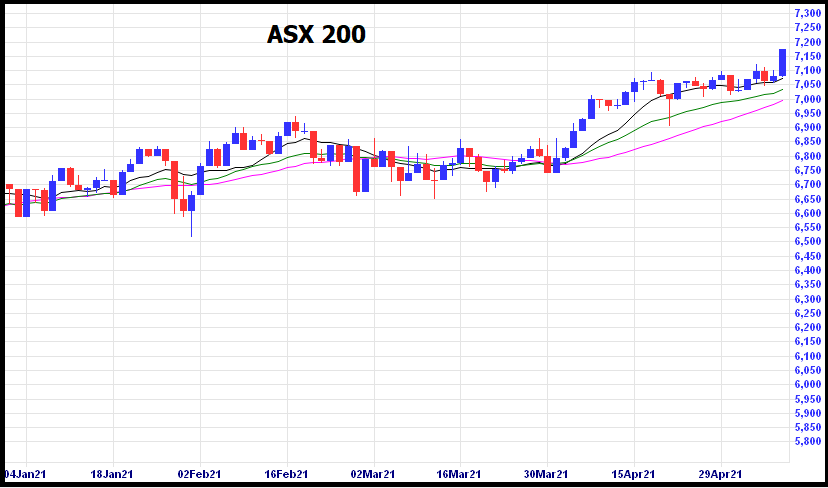
I have to admit that I follow my investments every few days through a portfolio in Yahoo Finance and will download prices to my accounting software – the free Microsoft Money Sunset International Edition available at the most excellent Ameridan’s Blog. I download share prices into Microsoft Money with MS Money Quotes with a 10 USD lifetime licence. In the USA, Personal Capital is recommended.
I am happy to say that, when on holiday, or busy, I have no need to monitor on the daily timescale. Regardless, no decisions are made on this daily basis.
Weekly
Weekly is where the “rubber hits the road” for Slack Investor – and I look forward to my weekly sessions with my portfolio. I set aside an hour on the weekend to make sure my portfolio prices are updated and the charts are reviewed. The weekly time scale smooths out a bit of the volatility and I then open up Incredible Charts to scroll through my portfolio.
Incredible charts offer a free month sign up and then $9.95 per month for access to worldwide updated delayed charts daily from 6pm Australian time. This package is not in “real time” and does not suit a day trader. But for an investor on my slower time scale, it is very good value. These charts open up the whole world of technical analysis as it allows you to monitor trends in your stocks and mark in trend lines and stop losses.
I have always used the weekly charts to make decisions on buying a company – looking for a momentum shift in the trading using the Directional Movement System. I also like to trade a “breakout”, or a “wedgie”
Monthly
This is the timescale when I am most happiest and would like to make decisions just every month. After a life of work where decisions were a constant grind – It is a gift not to make decisions!
It is still my aim to make selling decisions monthly – but when I feel that the market is “overvalued”, I am on a weekly decisions cycle for selling. The sell happens when a stock price finishes below my stop loss at the end of the week/month (see Technical Sell in Episode 6 below).
Yearly
This is the “Look at yourself in the mirror” period where Slack Investor does the evaluation of his portfolio performance against benchmarks at the end of each financial year. Although the financial year ends at June 30, it usually takes until the middle of August for me to get my final results and benchmarks together. I present my results at the annual Financial Year Results post.
Special Occasions Selling
Slack Investor is in one of those right now and he has to free up some cash to by selling some shares. I like to do things a bit methodically and here is my process for a sell.
In the meantime, like my pumpkin friend … always watching …
The Slack Way to Financial Freedom: Episode 6 – Managing Your Share Portfolio – Know when to Fold’em
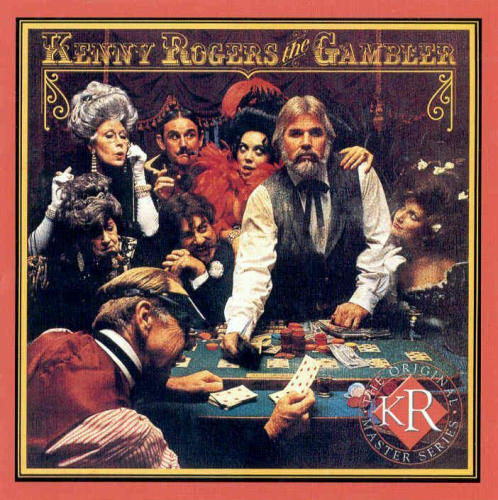
“He said, “If you’re gonna play the game, boy
You gotta learn to play it right …You’ve got to know when to hold ’em
Excerpt from “The Gambler” written by Don Schlitz and recorded by Kenny Rogers.
Know when to fold ’em
Know when to walk away
And know when to run
Kenny makes this sound easy, but selling shares is tricky and Slack Investor does not always get this decision right – and I’m OK with that. The Slack Investor art is just to attempt to get things “mostly right”. There are some stocks that I will hold for the long run, and their weekly and monthly charts are not of a big concern to me. However, about half of my portfolio is on a weekly or monthly watch – I review the Incredible Charts output for each of these stocks on the weekend or at the end of the month.
Technical Sell
This is my first port of call. Technical Analysis uses charts and trends and involves reviewing the charts on a weekly or monthly basis. A technical sell is triggered when the stock price falls below the pre-determined stop loss that I have set. I will then try to sell at the start of the next week/month. My rules are not rigid here, if the stock starts to rebound after I have made my sell decision, I might stick with it for a little while longer.
Another technical signal is when a stock loses its momentum – but this is a more subjective signal than when a stock simply moves below a line.
Technical Sell Examples
Slack Investor bought into ESPO in October 2020 at $10.39 and sold at a small loss $10.19 with a sell signal on the Weekly chart. The stock didn’t grow like I thought it would – but that’s fine. I like the concept of this ETF but I am happy to be out for now and look forward to be getting back in when a strong upward trend establishes itself.
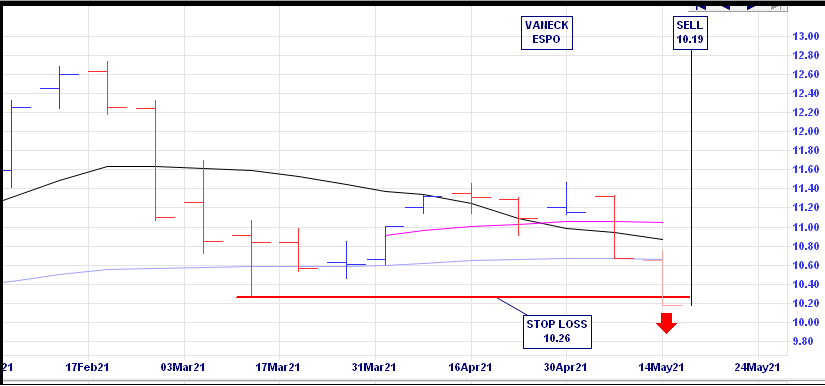
I also pay particular attention when the stock price falls below my stop loss on the monthly chart – this is a much stronger “call to act”. For the A2M monthly chart below, In hindsight, I should have been more alert to trends on the weekly chart. A2M is a good company with a unique product and has shown excellent growth in the last 5 years. However, earnings season is always a bit volatile for the growth sector.
The FY20 results showed a record profit but there were some question marks about FY21. The real catalyst for a downward price move was the later release of an acquisition and that members of the board and senior executive team had sold over 1.8 million shares. Selling by insiders is not always bad, as the executives might just be diversifying their portfolios – However, in this case, the market took a dim view. Overall, the A2 Milk Company Ltd (ASX: A2M) share price has slumped more than 15% since the release of its FY21 outlook.
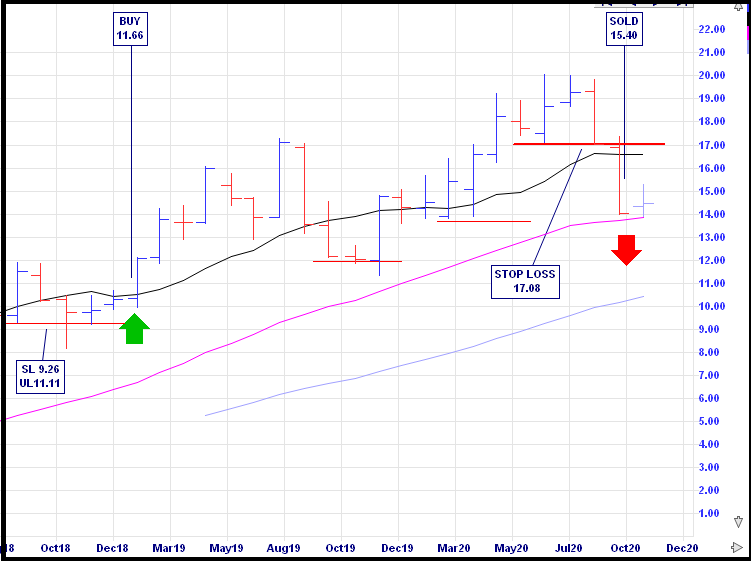
As luck would have it, I didn’t wait till the end of the month and pounced on the sell button on the day that the A2M fell more than 10%, 28th September 2020.
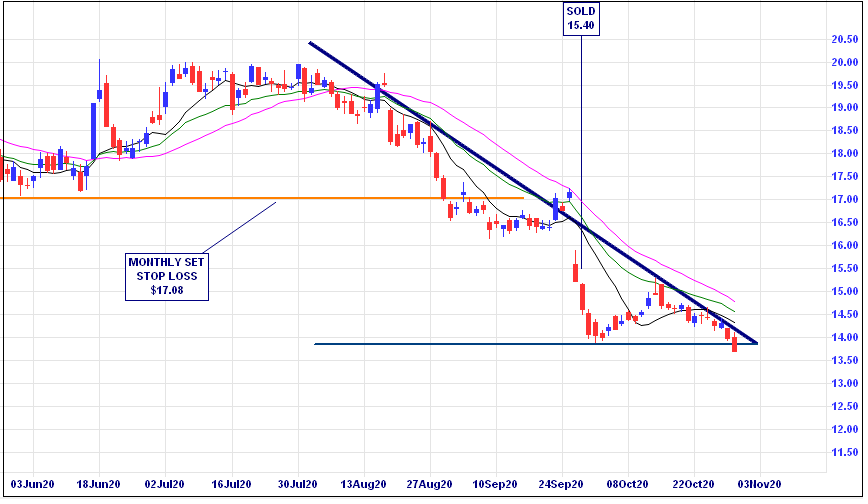
I am not put off A2M forever. The end of month share price was $13.67. There is now a reasonable case for re-investing given the growth pathway beyond 2021 and the Market Screener , relatively low, 2023 predicted PE of 19. There has now been a downward trend of 3 months and Slack Investor’s favourite pattern has started to emerge … “The Wedgie”. If there is a break above “the Wedgie”, I will think about a reinvest and hope the share price resumes an uptrend.
Fundamental Sell
Fundamental Analysis revolves around trying to determine the real value of a stock by looking at its financial data (e.g, Price/Earnings ratio, Return on Equity, Debt, etc) over time and, in reference to its competitors. This is a much more complicated process.
If Slack Investor can’t find a technical sell, I look for a fundamental sign. I will list all of my sellable stocks (Shares that I don’t hold for “the long run“). The first step is to get some financial data on each company from the very good Market Screener then put them in a table and hope that something stands out as a sell. A sell signal might be a trend of falling earnings, increasing debt, or decreasing Return on Equity (ROE). I also get nervous about a stock if its predicted (+ 2 years) Price Earnings (PE) ratio goes over 50. Fortunately, I didn’t have to resort to any fundamental analysis this this time … and this fundamental approach needs further elaboration …. stay tuned.
” … the secret to survivin’
Further … from The Gambler
is knowing what to throw away,
and knowing what to keep …”
Ooooh Kenny … the secret to investing is simple to describe, but harder to do … but you knew how to tell a good story!
The Slack Way to Financial Freedom: Episode 7 – Three Pile Theory
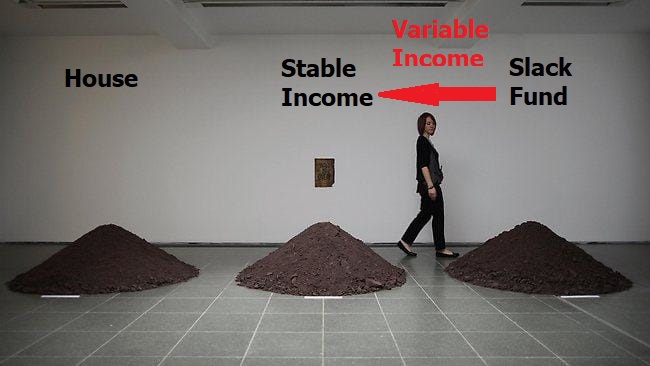
With apologies to Yoko for interfering with her art, but Slack Investor first thought of his own “Three Pile Theory” back in 1989 when I had got myself a “Proper Job” and enough stability in my life to make the big plunge into Real Estate. At that time, I owned a few grains of dirt in my House pile (the Bank owned the rest), My income was OK, and my investments (which would later morph into the Slack Fund) contained a few thousand dollars in shares.
Now, 32 years later, Slack Investor still has these three financial pillars to keep himself steady.
- House – Home ownership gives me great security and pleasure. The bank owned most of this 30 years ago – but now I have the upper hand! (~30% of Net Worth)
- Stable Income – This used to be my job, but in retirement I have some stable income annuity style investment (~20% of Net Worth) that would pay my bills and maintain a basic Slack Lifestyle should Armageddon befall the stock markets for a few years. This income is supplemented by income from the Slack Portfolio.
- Slack Portfolio Investments – (~50% of Net Worth) – Now currently in my Self Managed Super fund (SMSF) which is almost exclusively invested in growth companies. These are great businesses to be invested in if you have a long term horizon – however, stock prices can be volatile in these high Return on Equity (ROE) companies. I am currently retired and do not rely on the Slack Portfolio for stable income. Because of the stability of my other two pillars, I can be quite aggressive in the allocation of my investments in the Slack Portfolio – as I know I will not have to panic sell (for income) during any downturn.
Slack Investor didn’t really invent “Pile theory” – it has been around for a while in various guises – Three Buckets is a tried and true way to manage your retirement expenses by dividing your retirement stash into buckets of cash, conservative investments and more risky, growth investments.
House

My home may not feel like a palace to you, but to me, it is a whole Kingdom.Prerona Chatterjee
There are some who argue that you are financially better off by renting over a 10-year period rather than buying. But for Slack Investor, the tax advantages – no capital gains tax on your own home in Australia; the leverage – banks are usually willing to lend at least 80% of the house value; the forced saving – your mortgage payment is a big monthly portion of your income which you set aside for a long period; and, the stability provided by home ownership make this a clear winner for me. “The Serenity” is just a bonus.
Stable Income

To cover living expenses and to give yourself “peace of mind” it is so important to have a slab of money that is not subject to the vagaries of the sharemarket. In Australia, if you haven’t enough super to go independently, you might qualify for a full or part pension.
If going the fully self-funded route, many advisors recommend your stable income should be in two parts. You should work out your living expenses for a year and then keep between 2 and 5 years worth of expenses in stable cash deposits – Let’s start with 3 years of expenses in accessible cash. The rest of you stable income pile can be in longer term cash deposits, bonds or REITS. Because the investments pile (Slack Portfolio) is in growth shares that can be very volatile, my stable income must be something that is not highly correlated to to the sharemarket.
Term Deposits– although interest rates are woefully low now on bank term deposits, it is still possible to get ~1% p.a. from some of the minor banks that still have the Government Guarantee for the first $250 000.
Vanguard Australian Fixed Interest Index ETF (VAF)
MER (0.20%) – Annual performance over 1/5 years – (3.81%/4.41%)
Vanguard Australian Government Bond Index ETF (VGB)
MER (0.20%) – Annual performance over 1/5 years – (4.08%/4.49%)
Challenger Fixed Term Annuity – Rates are pretty low at the moment, locking away a deposit for 5 years will earn a measly 1.65%.
Real Estate or Real Estate Investment Trusts (REIT) – these are a bit higher up the risk curve but as they produce income (rent) and can be associated with longer term leases – are usually less volatile than the share market. For example, Vanguard Australian Property Securities Index ETF (VAP) – MER (0.23%) – Annual performance over 1/5 years – (-13.3%/6.23%)
Investments – The Slack Fund

Because the Slack Portfolio is mostly in growth shares, I have steeled myself that this particular pile is volatile and changes value every day. I am prepared for a few low performing (or even negative) years in a row for this pile. Even great investors that have much more knowledge than Slack Investor have the occasional bad year – during some periods, share investments just perform poorly. I am accepting of this truth.
Because this Investment pile is mostly in my Self Managed Super Fund (SMSF), I am usually obliged to withdraw 4% of its total value each year – this percentage increases with age – but this payment is currently tax free for those over 60. I can use this income in a discretionary way. My living expenses should be covered by income from the Stable Income pile – and any other income is gravy.
Pile Rebalancing
Once you are in a house that you are happy in and hopefully will be near paying off any outstanding loans as you get into retirement – other than maintenance, you can leave this pile alone.
The Stable Income cash pile might occasionally need a bit of topping up from the longer term stable Income or Investments fund. Any dividend or interest income from your investments is fair game. The investment Slack Fund usually produces 2 -3% income.
Hopefully, with 3-years worth of living expenses in the stable income pile, you can ride out a few bad years in the share market and only sell shares to top up the stable income pile when the share market has had a good run. Ideally, you would only sell share assets out of this pile when the share market is above the long term trend line. However, realistically, from the chart below (in red) there are long periods when the market is below trend. Have no fear, your basic expenses are always covered by a mixture of stable income, interest and dividends.
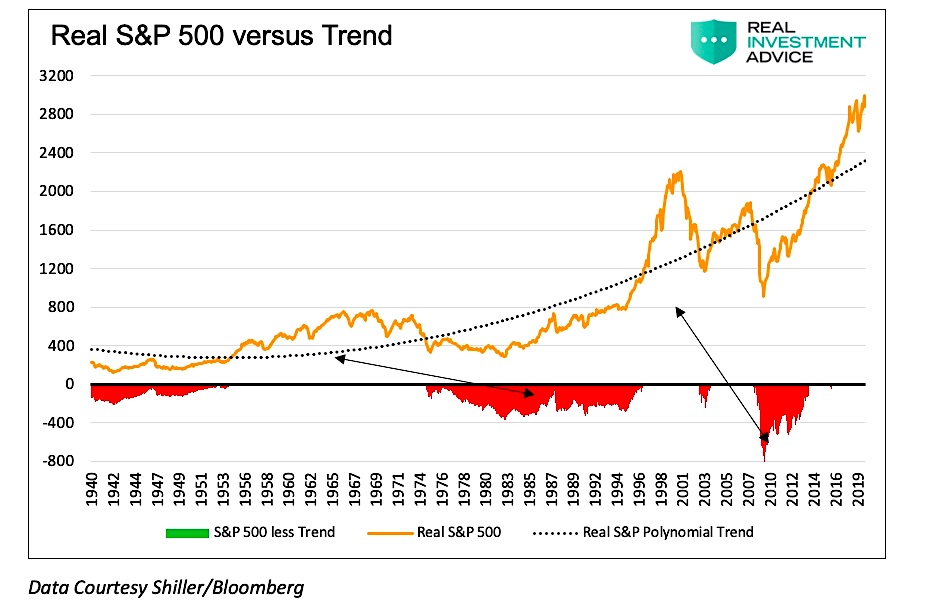
There are other piles worthy of attention such as Health and Relationships but the finance stuff is necessary too. So get the shovel out … and start working on those piles!
The Slack Way to Financial Freedom: Episode 9 – Portfolio Performance and Benchmarking
My main cycle of measurement is at the end of the tax year in Australia, June 30. Because the results of one-year performance can be a bit misleading. I am much more focused on results over 5 years as these longer term measures are more meaningful to the investor. The benchmarks I have used come from a range of sources. A shout out to the low-cost ETF Vanguard Diversified Growth Index (VDGR; MER 0.27%), or the managed fund that it is based on Vanguard Growth Index Fund. When I tire of investing in individual companies, this (or other Vanguard ETF’s) are the type of vehicle that is a good resting place for funds that require minimal supervision.
The Five-year compound annual performance gives me a much better idea about how things are going and will smooth out any dud (or remarkable!) results.
Year by year Slack Fund Internal Rates of Return are presented in table form below and compared to benchmarks.
For this site I have only presented my share trading results since 2009. Any cherry-picking of data to avoid the terrible investing years of 2008 and 2009 is coincidental. Out of the ashes of the Global Financial Crisis (Great Recession), 2009 is the year that I started my Self Managed Super Fund (SMSF Slack Fund) and from which I have independently audited results. For the record, prior to 2012, I was not what I regard as a very organized, or successful, investor. My investments for the 2003-2011 period performed worse than the Median Balanced fund on 6 out of 9 occasions.
| YEAR | SLACK FUND | MEDIAN BAL | VGARD GROWTH | ASX200Acc | RES BRIS | RES MELB | CASH | CPI |
|---|---|---|---|---|---|---|---|---|
| 2010 | 6.6 | 9.8 | 12.3 | 13.1 | 10.8 | 26.9 | 4.2 | 3.1 |
| 2011 | 2.5 | 8.7 | 9.1 | 11.7 | -2.4 | 0.9 | 4.4 | 3.7 |
| 2012 | 8.3 | 0.4 | 1.3 | -6.7 | 1.3 | -0.9 | 4.3 | 1.2 |
| 2013 | 26.5 | 14.7 | 18.6 | 22.8 | 7.7 | 8.3 | 3.2 | 2.4 |
| 2014 | 23.6 | 12.7 | 14.5 | 17.4 | 11.5 | 12.8 | 2.6 | 3.0 |
| 2015 | 2.4 | 9.6 | 11.8 | 5.7 | 7.7 | 15.6 | 2.5 | 1.5 |
| 2016 | 14.2 | 3.1 | 4.2 | 0.6 | 8.4 | 9.5 | 2.2 | 1.3 |
| 2017 | 19.5 | 8.1 | 8.8 | 14.1 | 6.5 | 17.7 | 1.9 | 1.9 |
| 2018 | 37.6 | 7.2 | 10.0 | 13.0 | 5.2 | 3.9 | 3.9 | 2.1 |
| 2019 | 19.7 | 6.2 | 9.8 | 11.5 | 1.7 | -6.0 | 2.0 | 1.3 |
| 2020 | 9.4 | 0.3 | 0.6 | -7.7 | 8.4 | 13.8 | 1.1 | -0.3 |
| 2021 | 21.7 | 13.0 | 20.3 | 27.8 | 17.9 | 10.7 | 0.2 | 3.8 |
The Slack Fund yearly progress vs BENCHMARKS. The Median Balanced Fund (41-60% Growth Assets), Vanguard Growth Fund, ASX 200 Accumulation Index, Corelogic Residential Property total return in both Brisbane and Melbourne, and Cash (Australian Super Cash Fund) and Consumer Price Index (CPI)
The five-year compound annual performance gives me a much better idea about how things are going and will smooth out any dud (or remarkable!) results.

The beauty of compounding with a succession of good performance results can be seen in the chart below showing the growth of an initial investment in June 2009 of $10000.

